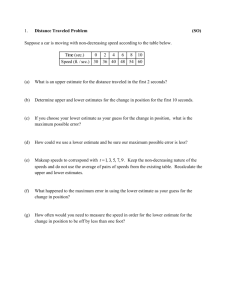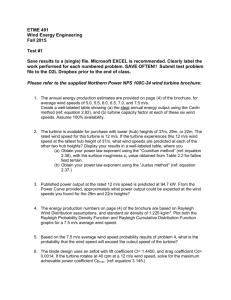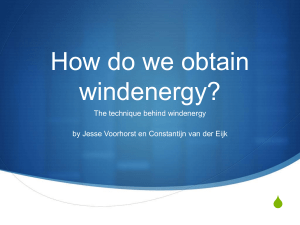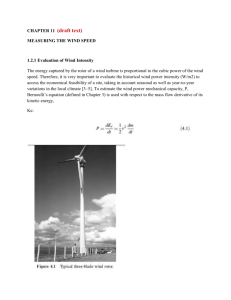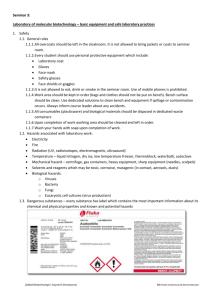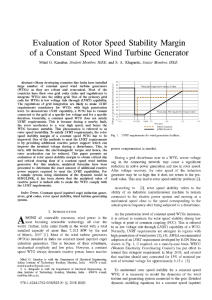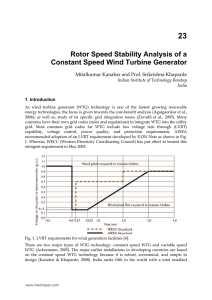Summary
advertisement
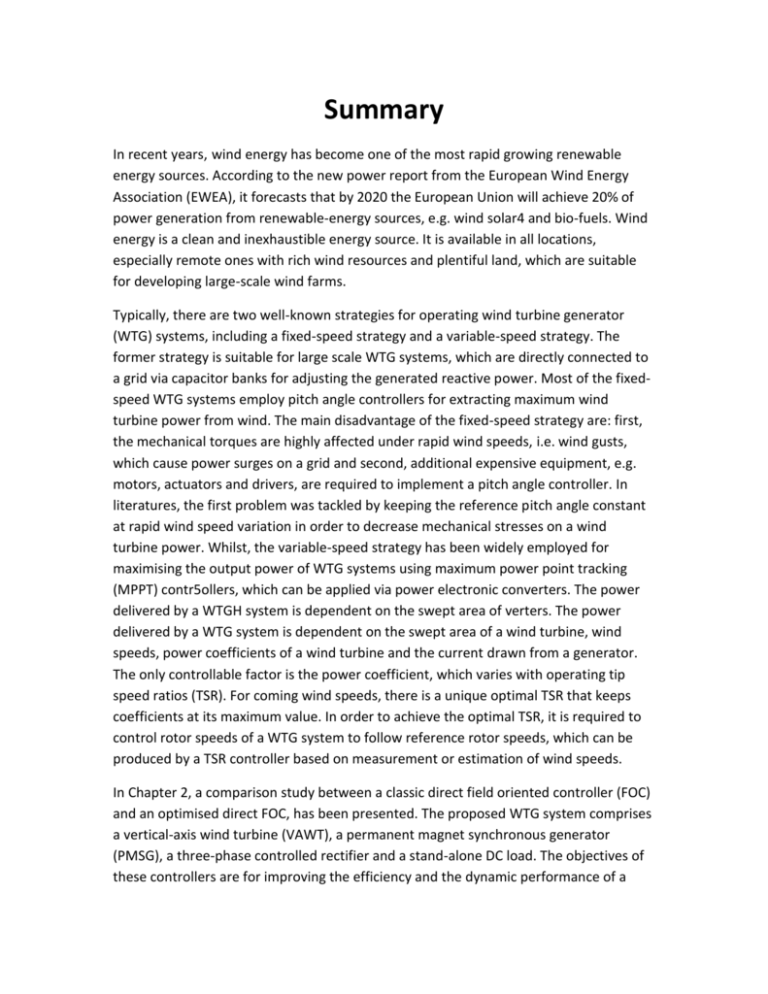
Summary In recent years, wind energy has become one of the most rapid growing renewable energy sources. According to the new power report from the European Wind Energy Association (EWEA), it forecasts that by 2020 the European Union will achieve 20% of power generation from renewable-energy sources, e.g. wind solar4 and bio-fuels. Wind energy is a clean and inexhaustible energy source. It is available in all locations, especially remote ones with rich wind resources and plentiful land, which are suitable for developing large-scale wind farms. Typically, there are two well-known strategies for operating wind turbine generator (WTG) systems, including a fixed-speed strategy and a variable-speed strategy. The former strategy is suitable for large scale WTG systems, which are directly connected to a grid via capacitor banks for adjusting the generated reactive power. Most of the fixedspeed WTG systems employ pitch angle controllers for extracting maximum wind turbine power from wind. The main disadvantage of the fixed-speed strategy are: first, the mechanical torques are highly affected under rapid wind speeds, i.e. wind gusts, which cause power surges on a grid and second, additional expensive equipment, e.g. motors, actuators and drivers, are required to implement a pitch angle controller. In literatures, the first problem was tackled by keeping the reference pitch angle constant at rapid wind speed variation in order to decrease mechanical stresses on a wind turbine power. Whilst, the variable-speed strategy has been widely employed for maximising the output power of WTG systems using maximum power point tracking (MPPT) contr5ollers, which can be applied via power electronic converters. The power delivered by a WTGH system is dependent on the swept area of verters. The power delivered by a WTG system is dependent on the swept area of a wind turbine, wind speeds, power coefficients of a wind turbine and the current drawn from a generator. The only controllable factor is the power coefficient, which varies with operating tip speed ratios (TSR). For coming wind speeds, there is a unique optimal TSR that keeps coefficients at its maximum value. In order to achieve the optimal TSR, it is required to control rotor speeds of a WTG system to follow reference rotor speeds, which can be produced by a TSR controller based on measurement or estimation of wind speeds. In Chapter 2, a comparison study between a classic direct field oriented controller (FOC) and an optimised direct FOC, has been presented. The proposed WTG system comprises a vertical-axis wind turbine (VAWT), a permanent magnet synchronous generator (PMSG), a three-phase controlled rectifier and a stand-alone DC load. The objectives of these controllers are for improving the efficiency and the dynamic performance of a WTG system as well as minimising rotor speed overshoots under rapid wind speed variation. The developed controllers are based on a well-known FOC method, through adjusting stator currents and consequently electromagnetic torque. FOC transformers three-phase stator currents into two currents in the rotational reference frame, i.e. d-axis and q-axis currents, using the Park transformation. These daxis and q-axis currents act as DC currents. To apply FOC, reference rotor speeds or reference electromagnetic torques are required to generate reference q-axis currents, whilst reference d-axis currents are usually set as zero for minimising loss. It is important to note that the Park transformation needs to knowledge of rotor positions, which can be measured by an encoder. In practice, an encoder cannot measure an accurate initial position, which may lead to wrong calculations of d-axis and q-axis currents. It is worth nothing that the parameters of a PI current controller are firstly turned using a classic zero and pole placement method and secondly optimised using a particle swarm optimisation (PSO) algorithm. The PSO algorithm is adapted due to the following advantages: such as easy to implement with simulation in real-time, a high computational efficiency and stable convergence characteristics. An accurate model for a PMSG is important for a design of a high-performance PMSG control system, because the performance of such control systems influenced by PMSG physical parameter variation under real operation conditions. In this research, electrical parameters of a PMSG are optimally identified, e.g. the stator resistance per phase, the stator inductance per phase and the rotor permanent magnet flux linkage, using also a PSO algorithm. It is important nothing that the bounds of these parameters are obtained using standard tests, e.g. an open-circuit test, a short-circuit test and a load test. The aim is to increase the accuracy of parameter identification, reduce the search space of parameters and decrease the convergence time of a PSO algorithm, i.e. the computation time required to reach an optimal solution. One of the difficulties for implementing the direct vector control strategy is the requirement to fix an anemometer close to wind turbine blades in order to obtain accurate wind speed measurements, otherwise inaccurate calculations of reference rotational speeds are obtained causing a WTG system not to rotate at optimal speeds. For cost and reliability consideration, a sensorless MPPT controller, which is based on a novel TSE observer is developed. The purpose of the proposed TSR observer is for estimating TSRs and consequently reference rotor speeds without the knowledge of wind speeds. The purposed TSR observer is based on the well-known perturbation and observation (P&O) method. It is also known as the hill-climbing searching method, which doesn’t require any previous knowledge of wind turbine and generator characteristics. In spite of these advantages, it has some problems, which considerably decrease its dynamic performance. These problems include the steady-state oscillations around a maximum power point, a slow tracking speed, a perturbation process in a wrong direction and a high rotor speed overshoot under fast wind speed variations. In this research, those problems are tackled by using adaptive perturbation step sizes instead of fixed ones. For implementing the proposed MPPT controller, a cost-effective power-electronics converter, which consists of a three-phase diode rectifier and a DCDC boost converter, is constructed for experiments. Furthermore, a complete transfer function of the proposed system has been derived, which is employed to design a speed observer for estimating rotor speeds and consequently, rotor positions and for testing the stability of the developed rotor speeds observes and controllers. In this thesis, another robust sensorless MPPT controller has been proposed for maximising the output power of a WTG system. A switch-mode rectifier (SMR), which includes a three-phase diode rectifier and a DC-DC boost converter without a boost inductance with an in put capacitor filter for harmonic mitigation, is employed for implementing the proposed sensorless MPPT controller. The proposed sensorless MPPT controller is based on two novel observers, i.e. an adaptive sliding-mode observer (SMO) and an adaptive P&O algorithm. The former is used for estimating back-EMFs and consequently rotor speeds without the knowledge of rotor positions using an adaptive PMSG model in the stationary α-β reference frame, an adaptive sliding gain and an adaptive cutoff-frequency LPF. The purpose is to eliminate the chattering effect (which occurs in conventional SMOs) and decrease estimation errors. The adaptive P&O algorithm is developed to estimate reference rotor speeds and optimal duty cycles based upon turbine coefficient errors and rotor speed errors, respectively. It uses adaptive variables compared with some widely used P&G algorithm, which use an adaptive perturbation step size but a fixed observation period. The adaptive variables are: (i) a perturbation step size, which decreases steady-state oscillations around optimal operating power points and (ii) an observation period, which is another contribution of this work. It increases the tracking speed and ensures that MPPT is always executed in the right direction with small rotor speed overshoots under fast wind speed variations. It should be noted that the developed sensorless MPPT controllers are experimentally validated using a WTG simulator. The data acquisition and control stage of the power electronic converters are implemented using a digital signal processing and control engineering (dSPACE) controller. In this thesis, the analysis of experimental results has been undertaken to verify the proposed observers and controllers. Finally, future research work is suggested.
